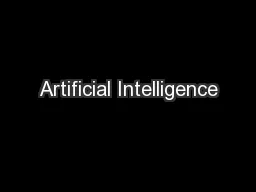/


Presented by Oliwual Islam Vivek Mishra Rahul Ravish ID: 619409
Download Presentation The PPT/PDF document "Artificial Intelligence" is the property of its rightful owner. Permission is granted to download and print the materials on this web site for personal, non-commercial use only, and to display it on your personal computer provided you do not modify the materials and that you retain all copyright notices contained in the materials. By downloading content from our website, you accept the terms of this agreement.
Slide1
Artificial Intelligence
Presented by: Oliwual Islam Vivek Mishra Rahul Ravish Rishika Jain Sheetal Slide2
What is AI:- Ai is the science of making machine do things that would requires intelligence. Computers with the ability to mimic or
duplicate the functions of the human brain Ai concerned with two basic ideasIt involves thought process of humansIt deals with human process via machineSlide3
WHY DO AI:-To understand human intelligence better. We test theories of human intelligence by writing programs which emulate it.To create useful “smart” programs able to do tasks that would normally require a human expert.Slide4
Computer SciencePsychology (human reasoning)Philosophy (nature of belief, rationality , etc)Linguistics (structure and meaning of language) Human Biology (how brain works)
How DOES AI:-Slide5
Major Branches of AI (1)Perceptive system
A system that approximates the way a human see, hears, and feels objectsVision systemCapture, store, and manipulate visual images and picturesRoboticsMechanical and computer devices that perform tedious tasks with high precisionExpert systemStores knowledge and makes inferencesSlide6
Major Branches of AI (2)Learning system
Computer changes how it functions or reacts to situations based on feedbackNatural language processingComputers understand and react to statements and commands made in a “natural” language, such as EnglishNeural networkComputer system that can act like or simulate the functioning of the human brainSchematicSlide7
ArtificialintelligenceRobotics
VisionsystemsLearningsystemsNatural languageprocessingNeural networksExpert systemsSlide8
Applications of Artificial Intelligence
Information managementAI and expert systems embedded in productsPlant layoutHospitals and medical facilitiesHelp desks and assistanceEmployee performance evaluationLoan analysisVirus detectionRepair and maintenanceShippingMarketingWarehouse optimizationSlide9
1) AI will force a dualistic view of life to change because the environment will be inseprable from it. 2)On the other hand, most scientists would be happy to view the brain as a vast but complex machine.As such it should then be possible to purely replicate the brain using artificial neurons. This has already been done for very simple life forms such as insects which only have a few thousand neurons in their brain. 3) Smarter artificial intelligence promises to replace human jobs, freeing people for other pursuits by automating manufacturing and transportations.
4) AI can see relationships in enormous or diverse bodies of data that a human could not. ADVANTAGES :-Slide10Slide11
Disadvantages (Risks)Potential for malevolent programs, “cold war” between two countries, unforeseen impacts because it is complex technology, environmental consequences will most likely be minimal.Frequently mutating computer virus.Military robots may make it possible for a country to indiscriminately attack less-advanced countries with few, if any, human casualties.Rapid advances in AI could mean massive structural unemployment.AI utilizing non-transparent learning (i.e. neural networks) is never completely predictableSlide12
Idea of Artificial Intelligence is being replaced by Artificial life, or anything with a form or body. The consensus among scientists is that a requirement for life is that it has an embodiment in some physical form, but this will change. Programs may not fit this requirement for life yet.
The Future?Slide13
Overview of Artificial Intelligence Intelligent
behaviourLearn from experienceApply knowledge acquired from experienceHandle complex situationsSolve problems when important information is missingDetermine what is importantReact quickly and correctly to a new situationUnderstand visual imagesProcess and manipulate symbolsBe creative and imaginativeSlide14
BIBLIOGRAPHYEssence of Artificial Intelligence” by Alison Cawsey, Prentice Hall.Artificial Intelligence: A Modern Approach (second edition), Russell & Norvig, Prentice Hall. 2003Artificial Intelligence: Structures and Strategies for Complex Problem Solving, Luger, Benjamin Cummings. Slides, lab exercises etc. www.macs.hw.ac.uk/~alison/ai3/
PICS from:- WWW.google.COMSlide15